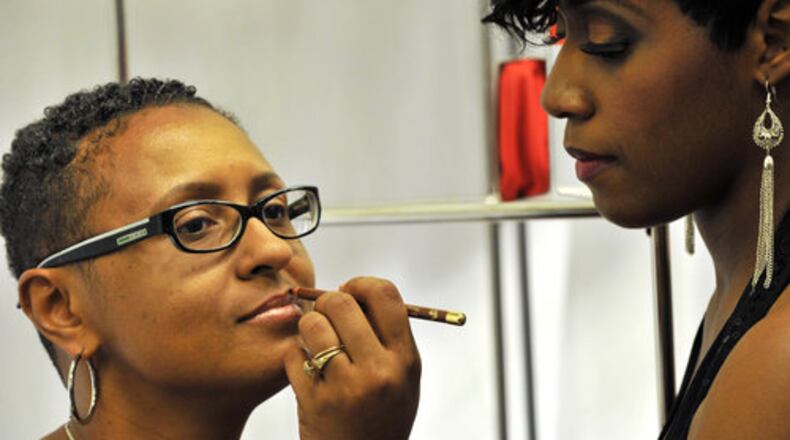In 1997, just a few years after she moved from her native New Orleans to Atlanta, Renee Knorr was given the opportunity of a lifetime. She was selected as a model for Ebony Fashion Fair, the annual touring fashion show run for more than 50 years by Eunice Johnson, the co-founder of Johnson Publishing Company.
Knorr was excited to be part of the event, which first came to metro Atlanta in 1960 and exposed African Americans across the country to high-end fashions modeled by people who looked like them.
Frustrated that Ebony Fashion Fair models had trouble finding makeup shades that suited their skin tones, in1973 Johnson created Ebony Fashion Fair cosmetics. It would become the go-to makeup brand for generations of African American women.
When Knorr learned that as a model she was entitled to as much makeup from Fashion Fair as she wanted, she called her mom and said, “I did it! Now we have makeup forever!”
I’m a native of Chicago, the hometown of Johnson Publishing Company, and I had my own love affair with Fashion Fair. My mother’s makeup drawer was filled with lipstick, compacts and palettes in the iconic plastic pink packaging. Our trips to the annual fashion show when I was a teenager were the one occasion when I was allowed to wear makeup.
A few years ago, I went on a nostalgic search for the lipstick color I had once swiped from my mother’s makeup drawer in the 1980s. For reasons unknown, I desperately felt the need for a tube of Fashion Fair’s Chocolate Raspberry.
This is a testament to the iconic nature of the brand, that some 30 years later, I would remember the name of a lipstick color that served as a cross-generational connection between a mother and daughter. But I couldn’t find a single store that had any stock of the lipstick and most had little stock of any other Fashion Fair products. I realized then that the brand was in trouble.
In 2019, Johnson Publishing Company, the parent of Fashion Fair, went bankrupt. Later that year, Desiree Rogers and Cheryl Mayberry McKissack purchased the beleaguered brand out of bankruptcy. They were both former executives of Johnson Publishing Company (Rogers was also the first Black social secretary for the White House), well acquainted with Fashion Fair and just a few months earlier had purchased the mass market makeup brand, Black Opal.
“We had to take a step back and think about the legacy here,” said Rogers when I spoke with her by phone. “I spent many hours behind counters talking to consumers and people who work with Fashion Fair ... asking what does the brand mean to them?”
It may seem frivolous to think that makeup of all things could serve as some sort of cultural affirmation but Fashion Fair was the first brand founded and created by a Black woman that let every Black woman know she deserved to be seen and acknowledged in all her glory.
McKissack and Rogers created a beauty manifesto — an ode to Black women and our history — to serve as their north star when deciding how they would relaunch the legacy brand. “Whenever it got really hard I read that manifesto and it was a beautiful salute to all that is and will be and has been Black women,” said Rogers. “Our fashion, our glamour, our beauty. We wanted to honor the historical past but we wanted to be cognizant of what 2020 and beyond looks like.”
The makeup industry has changed a lot since Fashion Fair burst onto the scene in the ‘70s. At that time, most major cosmetics companies offered few products that were color appropriate for darker skin tones. The only cosmetics brand specifically for Black women that sold in department stores was created by a blond-haired, blue-eyed former actress named Flori Roberts.
Over the decades, more makeup brands — both corporate backed and independent — have recognized the value in offering extended color palettes, shrinking the gaps that have long existed in the industry.
“I think it is wonderful we have so many options in the market place. It is wonderful seeing so many smaller brands coming that are founded or owned by people of color. It is long overdue,” Rogers said. “We spend so much money on cosmetics and nail care. It is about time you see women who look like us on the other side of the table.”
But Fashion Fair she said, is the queen of them all and the queen is ready to reclaim her crown. Rogers said they began looking at the full line of Fashion Fair Cosmetics and recreating select items with cleaner and vegan formulations. The line currently consists of 14 lipstick shades, including popular colors from the past, a serum developed by Black dermatologist Dr. Caroline Robinson, loose and pressed powders and two formulations of foundation — stick and cream to powder.
One of the biggest challenges was how to address the iconic pink packaging. “That has been a romanticized vision of Fashion Fair but was it as modern as we wanted the brand to be?” Rogers said. They settled on white and gold packaging with a promise to bring back pink on special occasions.
The brand is currently sold in Sephora stores but also has an online presence. “This is much harder than I think people realize especially when you are dealing with such an iconic brand,” McKissack said. “How do we honor the legacy and how do we move into the world people are in today?”
Online consulting and shade matching are available at fashionfair.com, as well as a virtual try-on experience. McKissack said they have also engaged influencers and recently hosted a Zoom party with longtime Fashion Fair fans. “We will weave in everything that has been historical,” McKissack said “but will also be looking forward and that will introduce the product to a new generation.”
Part of that introduction may include a partnership with Spelman College in the form of a scholarship program and industry training, said Rogers. It’s an extension of the brand’s philanthropic past and the influence it has had over hundreds of young women.
Tanya Du’Shay, a former Fashion Fair model from 1984, said working with Fashion Fair cosmetics is what gave her a start in the makeup industry.
Du’Shay, who had a flair for the dramatic, would order boxes of Fashion Fair makeup and use the vibrant colors to emulate the makeup styles of Boy George, the gender-bending singer and songwriter from the ‘80s who was known for dramatic looks.
When her season with the fashion show ended, Du’Shay turned her experiences into a career as a makeup artist for top Black celebrities.
“(Fashion Fair) changed our lives and continues to change our lives,” said Knorr. “I am grateful they are doing the relaunch. Ebony really meant so much for the Black community.”
Read more on the Real Life blog (www.ajc.com/opinion/real-life-blog/) and find Nedra on Facebook (www.facebook.com/AJCRealLifeColumn) and Twitter (@nrhoneajc) or email her at nedra.rhone@ajc.com.
About the Author
Keep Reading
The Latest
Featured





